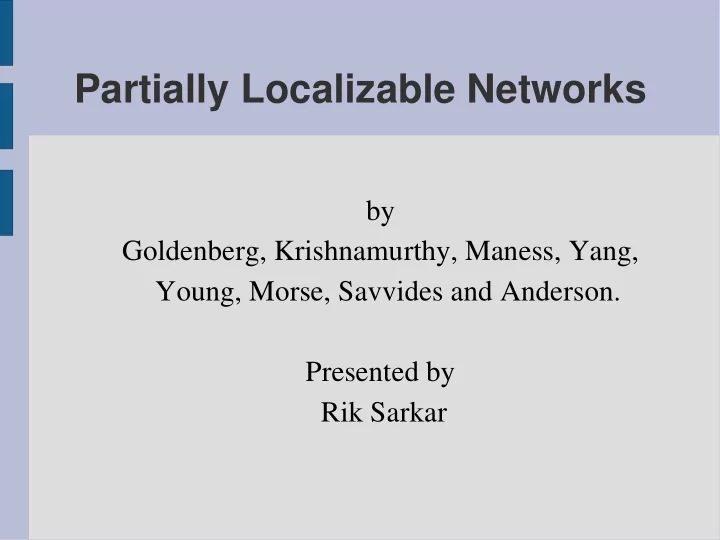

Partially Localizable Networks by Goldenberg, Krishnamurthy, Maness, Yang, Young, Morse, Savvides and Anderson. Presented by Rik Sarkar
Overview ● Network Localization. ● Partially Localizable networks – PLNs ● A Formulation of Network Localizability ● Necessary and Sufficient Conditions ● Identifying Uniquely Localizable nodes ● Experimental Investigations (simulations) on Partially Localizable Networks.
Localization ● Useful for Routing, Tracking, Location based Query.... ● Difficult ● Perfect localization may not be possible ● Erroneous config. may result in wrong conclusions. ● Test if localization is possible. ● Eren et al. Test localizability of entire graphs .
Partial Localizability ● Real networks are not likely to be entirely localizable. ● Identify Uniquely Localizable nodes (A sufficient condition is presented here) ● Simulate systems. ● What to do with UnLocalizable nodes?
Uses of Knowing Unlocalizable Nodes ● They can be ignored! ● Use them for routing.. ● Make them localizable. ● Deploy beacons/nodes systematically.
Formulation of Global Network Localizability ● d (= 2 or 3) dimensions ● n nodes: m beacons, n-m non-beacons ● graph G given, with edges between nodes ● edge lengths are known ● Exact position of each beacon is known ● position of other nodes to be determined ● Graph Realization with edges between beacons – Grounded Graph
Conditions for Localizability(1) ● Rigidity ● 3 node disjoint paths to 3 beacons insufficient. ● A graph with 2n-3 edges is rigid if no subgraph has more than 2n'-3 edges.
Conditions for Localizability(2) ● Flip ambiguities ● A graph must be d+1 vertex connected.
Conditions for Localizability(3) ● Remove edge – flip – add edge. ● Require redundant rigidity. ● Require triconnectedness.
Necessary & Sufficient Conditions for Network Localizability in 2D ● 3 Non-collinear beacons. ● Redundant Rigidity ● Triconnectedness – 3 node disjoint paths between any two nodes. -Extend to Node Localizability
RRT-3Beacon ● 3 Beacons ● Redundant Rigidity ● Triconnectedness ● RRT-3Beacon
RRT-3B ● Sufficient – NOT Necessary ● Ex : RRT-3B fails, though a is uniquely localizable.
Identifying RRT Components ● Triconnectivity – remove vertices individually & check for biconnectivity. ● Use pebble game to get RR subgraphs. ● Use recursive algo: No Proof!
Simulation - % Localizable Nodes
Simulation – Increasing % of Beacons
Coverage of Sensed Area ● Coverage by All Nodes is Different from Coverage by Localizable Nodes. ● Much higher density needed for Localizable node coverage to match all-nodes coverage
Smart Beacon Deployment ● Put some beacons in, then add other beacons based on RRT analysis. ● Results vary by distribution
Event Based Network Training ● Use known planned events for localizations. ● Time synchronization needed. ● Uniform vs systematic dispersal of events. ● Optimum Strategy depends on network distribution/structure. ● Ex : events near beacons, events at periphery, events a little inside the peripheri..
Other Studies ● Effect of PLNs on network routing. ● Joint source and network localizations. ● Source/target has known signal strength – may be mobile.
Future ● Measurement errors ● Node deployment errors, eg. Beacon deployment errors like in systematic beacon deployment. ● Looking at existing applications/algorithms with the consideration of partial localizability.
Recommend
More recommend